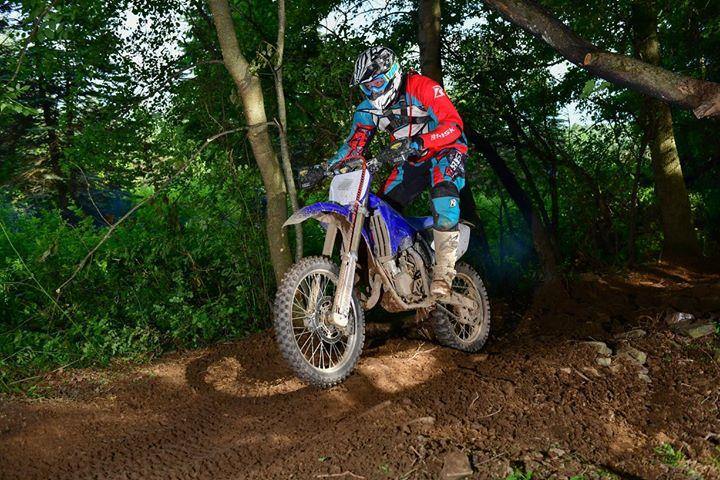Your Cart is Empty
MOTO Products
shop your way
Choose a shopping experience
Same great Risk Racing products, 3 completly different ways to shop them.
Choose a shopping experience
Same great Risk Racing products, 3 completly different ways to shop them.

Lifestyle Shopping

eComm Shopping

Catalog Shopping
MOTO TYRES
MOTO Gear & Apparel
How to Become a Pro GNCC Racer: The Complete Guide
July 27, 2020 6 min read

Motorcycle racing is an incredibly thrilling hobby. But what does it take to become a professional GNCC racer?
To become a professional GNCC racer, you will need to invest in the right equipment, make sure your AMA membership is up to date, pick the right class for your skill level, and register for the competition.
Keep reading to learn everything you need to know before becoming a Pro GNCC Racer.
Show Up at the Event
You can pre-register for the event online, but you can also sign up for the race on-site. To begin your GNCC Racing journey, all you have to do is show up to the competition and race! According to the official GNCC website, simply show up to the race track.
You will have to pay a race entry fee, and in exchange, you will be given a number for the race. There will also be a gate fee for every person that is in your group. Entrance for children under 6, though, is free.
Sign Up for the Race
You can sign up for the GNCC event in person when you arrive on-site, but it might save money and stress by pre-registering for the event online. It is recommended to sign up for the event online via the Rock Mountain ATV/MC Race Gas Fast Track Program.
If you choose to sign up at the event, you will need to fill out an entry form and a minor release, if necessary. Each rider will need to complete an entry form. Be sure to fill out every field in a neat, legible print.
If any riders in your group are under 18 years of age, they need to have a parent or guardian present. The parent or guardian must fill out and sign a minor release form before the young rider can compete.
If you are bringing a minor to the race and are not their parent, you will need to be sure to fill out a Parental Consent Form. The form needs to be notarized to be approved. Without a Parental Consent form, your rider cannot participate in the GNCC event.
Make Sure You Have Valid AMA Membership
To race in the GNCC events, you must have valid AMA membership.
AMA Membership is required to race in the GNCC. AMA is the American Motorcyclist Association, a nonprofit organization consisting of over 200,000 motorcyclists. They promote cycling life and sponsor several motorcycling events and activities.
AMA is also heavily involved in campaigning and lobbying for motorcyclist rights.
The size of AMA means that being a member will also help you cut deals on motorcycle gear and equipment. Your AMA membership will save you money on everything from protective gear, parts, to leatherware, hotels, and rental cars.
Membership will cost you $3.25 a month or $39 a year. It is an affordable membership, and using it actively is necessary to compete with GNCC. You can register for your AMA Membership online, on the AMA website.
Pick Your Class
There are many different classes to compete in, all separated by age and skill level. There are youth classes, and there are professional Pro XC1 levels. In between are levels of varying skill, ranging from “A” Expert and “B” intermediate, to “C” Novice.
Be sure to select the proper class. You might want to leap into the more intense categories right away, but you mustchoose a class according to your specific AMA classification.
The AMA rulebook outlines the classification rules and details how a rider gets classified. Riders must sign up for the race according to their current designated classification. But there is an appeal process that riders can file to change classes.
You can check your official AMA classification on the AMA Race Center. The online AMA Race Center keeps a list of all riders; every AMA rider has their own profile, listing their official rider classification.
Acquire a Transponder
Once you have your AMA membership and are all signed up, you will need to get a transponder. Transponders are required for all competitors.
The competition is scored via these transponders, so it is essential that every racer have one. You will be able to rent or buy a transponder prior to the event. They will be available to you at Rider Registration.
You can register for the race online, or at the Rider Registration area of the event itself.
At registration, transponders will be available to rent with cash or credit cards. You will have to leave a $90 deposit. When you return the transponder, you will get $80 back.
Once you acquire your transponder, you will need to mount it onto your motorcycle. Make sure it is securely mounted. Once it is attached to your bike, head to the registration trailer.
Head to the Registration Trailer
If you have not pre-registered online, you will now need to head to the registration trailer. In the registration trailer, you will sign the release form, and also receive your racing number.
Here is also where you will get your helmet sticker, pay your entrance fee, and fill out and sign your contingency forms. This is an essential logistical step before beginning to race.
If you have pre-registered online, you can skip ahead to the Fast Track.
Fast Track
For those that have pre-registered, head along to the fast track. Here you will sign your release. If you have any minors with you, here is also where you will turn in your minor release forms.
You will also receive your race number, helmet sticker, and event sticker here.
Pre-registration allows you to speed along the fast track, saving you time waiting in line for the registration trailer.
Pass Tech Inspection
The next step on your journey to becoming a Pro GNCC racer is to head to tech inspection. Your motorcycle must be in sturdy, strong condition, and comply with all your class rules.
Once you arrive at tech inspection, professionals will check your barcode and make sure your transponder is secure. They will double check your assigned number, and make sure your forms are up to date and that you are an eligible competitor.
While tech inspection will give your vehicle a cursory look, the individual riders are responsible for their machines' safety and durability.
The History of GNCC
If you are new to racing, it will help you to know the history of the GNCC. This will make you more prepared to tackle the course and compete in the high stakes races. Knowing the history of the event will help you blend in, and help you to prove you know your stuff.
The GNCC, or Grand National Cross Country Series, is an off-roading motorcycle racing series founded in 1975 by racer Dave Coombs.
The racing series is famous for its rugged, outdoors course—the competition sanctioned by the American Motorcyclist Association. In order to compete, you must be registered with the AMA.
The series was born when a preacher from a small West Virginia town reached out to Dave Coombs. The preacher wanted to help boost his town’s economy by hosting a motorcycle race. Coombs came, and in 1975 began what would become the Grand National Cross Country Series.
The GNCC is similar to motocross, but rather than being a small 1 to 3-mile tight compact course, it consists of an extended cross-country, off-road course. The roads are typically 8 to 12 miles long, and the competitions will often last up to three hours.
Today, GNCC Racing is no longer just the small, regional races. It has grown to huge professional events that bring in professionals and amateurs alike. Racers come from all around the world to compete in GNCC events.
The GNCC Racecourses are usually through intense, demanding terrain. Often there will be as many as 2,200 riders barreling through the course. The terrain varies from wooded areas to dust, mud, rocks, and hills. It is a challenging, rugged course.
The series consists of a variety of classes. There are classes for ATV and eMTB vehicles. The competition welcomes racers of all skill levels, and often both professionals and amateurs participate.
Conclusion
That’s everything you need to know about becoming a GNCC Racer. The more you race, the better you will get. Eventually, you may qualify for Pro classes!
Leave a comment
Comments will be approved before showing up.
Subscribe
Sign up to get the latest on sales, new releases and more …

Limited Time 10% Off
Save on your 1st order and get email offers when you join.
Eligible for first-time website purchases only. Emails may take a few minutes to process and could get flagged by email providers as junk so be sure to wait a little bit and check your junk and/or spam folders.

 UK/EU▾
UK/EU▾

























